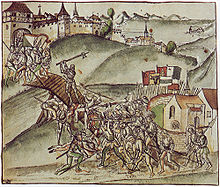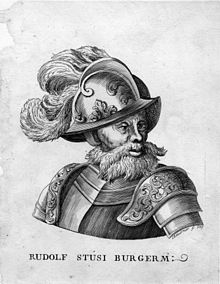Rudolf Stüssi (Mayor)
Rudolf Stüssi (*?; † July 22, 1443 in Zurich ) was mayor of the city of Zurich from 1430 to 1443.
Origin and career
Rudolf Stüssi's father of the same name came from Glarus and was granted citizenship in Zurich in 1375. He was elected guild master in 1388 and was in office as Obervogt in Küsnacht in 1393. His son Rudolf was a member of the council from 1414 and served as Obervogt in Männedorf (1415) and Höngg (1417), was appointed Zurich's envoy to the Swiss Federal Diet in 1424 and was elected guild master in 1426. In 1427 he was promoted to governor of the Confederation through the free offices .
From 1430 until his death Rudolf Stüssi was the 13th mayor of the city of Zurich. In 1433 he traveled as a representative of the imperial city of Zurich for the imperial coronation of Sigismund from Luxembourg to Rome, where he was knighted. During his tenure, Stüssi tried to greatly expand the territory of the city of Zurich. The Old Zurich War broke out between the Swiss Confederation and Zurich in 1436 over the dispute over the legacy of Count Friedrich VII of Toggenburg with the Canton of Schwyz . In the older Swiss historiography, strong references are made to the personal conflict between Stüssi, described as proud and bossy, and the Landammann von Schwyz, Ital Reding the Elder .
Conflicts

In Zurich there was a conflict between the Stüssis party and that of his co-mayor Meiss because of the threatened clashes. Meiss was arrested after the battle on the Etzel . Stüssi was able to assert himself in power despite the defeat of Zurich and in 1442 concluded an alliance with the German King Friedrich III. von Habsburg against the Swiss Confederation in order to still be able to achieve his goals. This alliance was particularly condemned by later Swiss historiography, because the House of Habsburg was regarded as the “arch enemy” of the Old Confederation.
When armed conflicts broke out again between the Confederates and Zurich, troops of Frederick III came. to Zurich. On July 22nd, 1443, Stüssi crossed the Sihl against the will of the Habsburg military leaders against the advancing Confederates. After the defeat of the people of Zurich near St. Jakob an der Sihl , Stüssi was killed while retreating over the Sihl . As the leader of the Zurich rearguard, he is said to have heroically defended the bridge (today the Sihl Bridge at Stauffacher / Badenerstrasse) to cover the withdrawal of the troops. He only fell when a Swiss comrade fatally wounded him with a pike from below the bridge. This is probably a legend, but his death on the bridge is testified.
Meaning and afterlife

For traditional historiography in Switzerland, Rudolf Stüssi was the prototype of the typical Zurich citizen: arrogant, greedy for power, proud and clever, but brave and heroic. Rudolf Stüssi's coat of arms consisted of a shield split by red and silver with chamois horns in alternating colors on a mountain of three.
Mayor Stüssi lived in the Königstuhl house at the Stüssihofstatt, named after his family, in the right-hand old town of Zurich. Contrary to the earlier view, the figure on the Stüssibrunnen cannot represent Stüssi, as it was only erected in 1575. The Zurich banner held by the figure also has a red flag stripe with the Swiss cross , which would hardly occur in combination with the figure of Stüssis.
See also
literature
- Karl Dändliker : Stüßi, Rudolf . In: Allgemeine Deutsche Biographie (ADB). Volume 37, Duncker & Humblot, Leipzig 1894, pp. 71-74.
Web links
- Martin Lassner: Rudolf Stüssi. In: Historical Lexicon of Switzerland .
- Historisch-Biographisches Lexikon der Schweiz, Vol. 6, Neuchâtel 1931, p. 590.
| personal data | |
|---|---|
| SURNAME | Stüssi, Rudolf |
| BRIEF DESCRIPTION | Mayor of Zurich |
| DATE OF BIRTH | 14th century or 15th century |
| DATE OF DEATH | July 22, 1443 |
| Place of death | Zurich |


